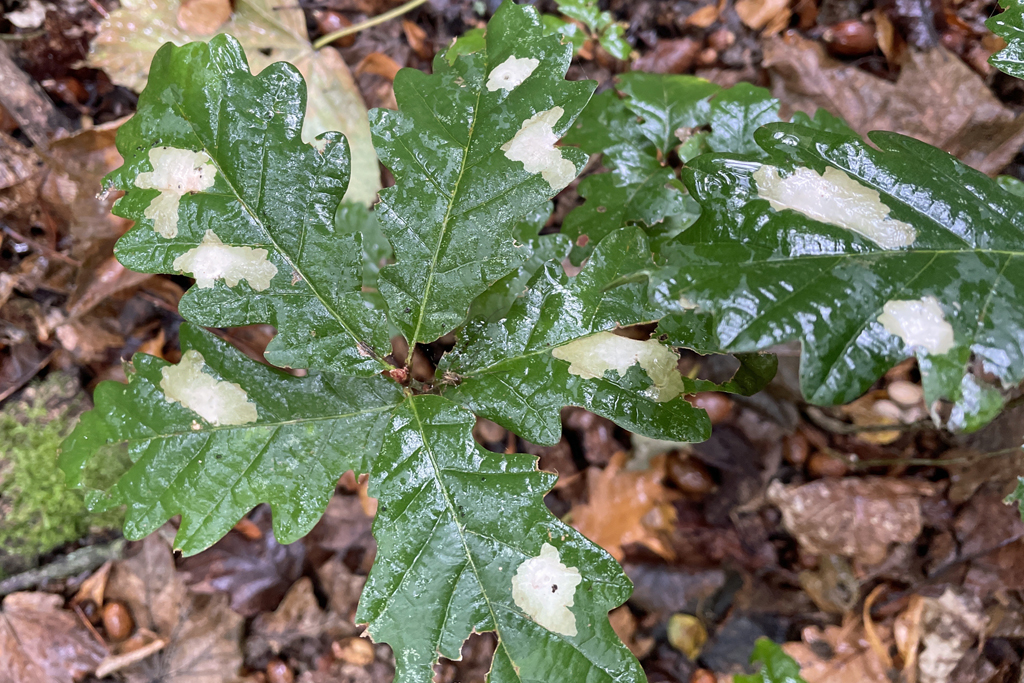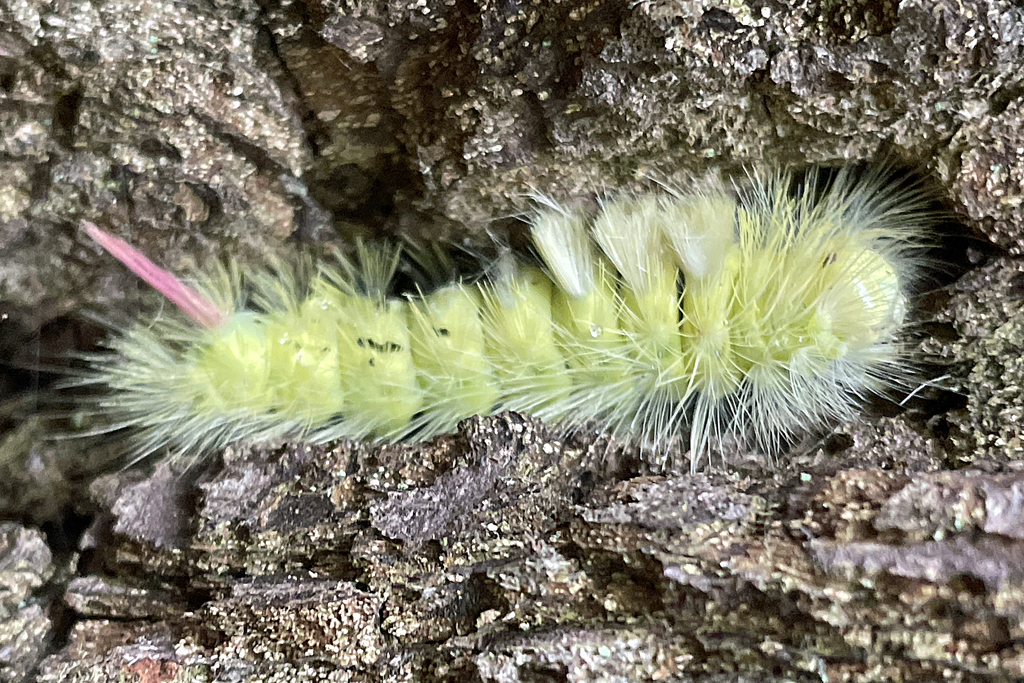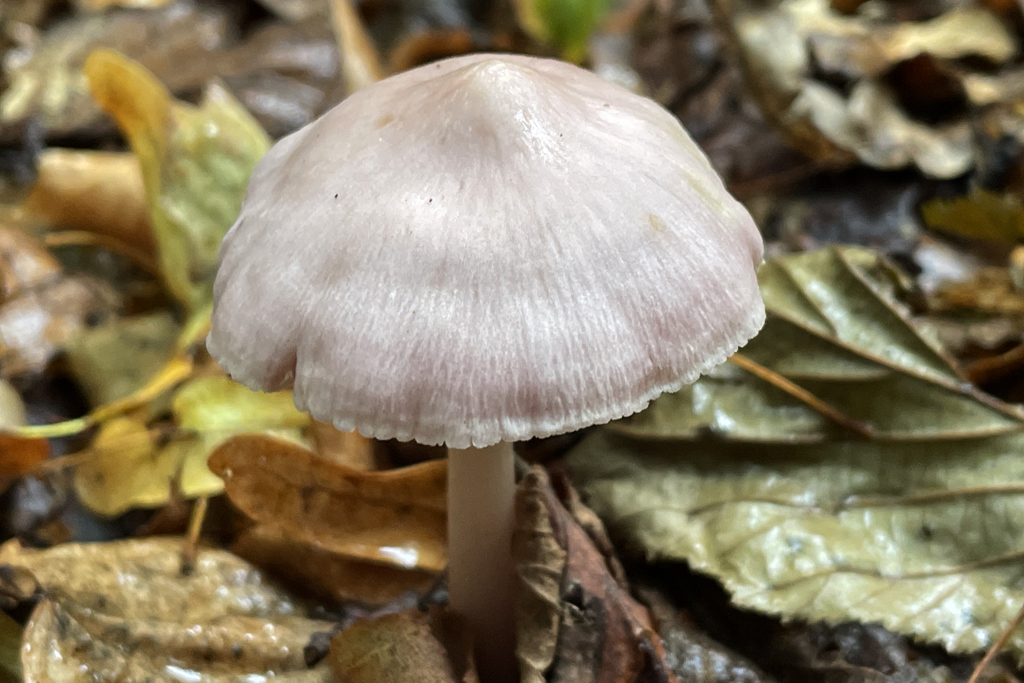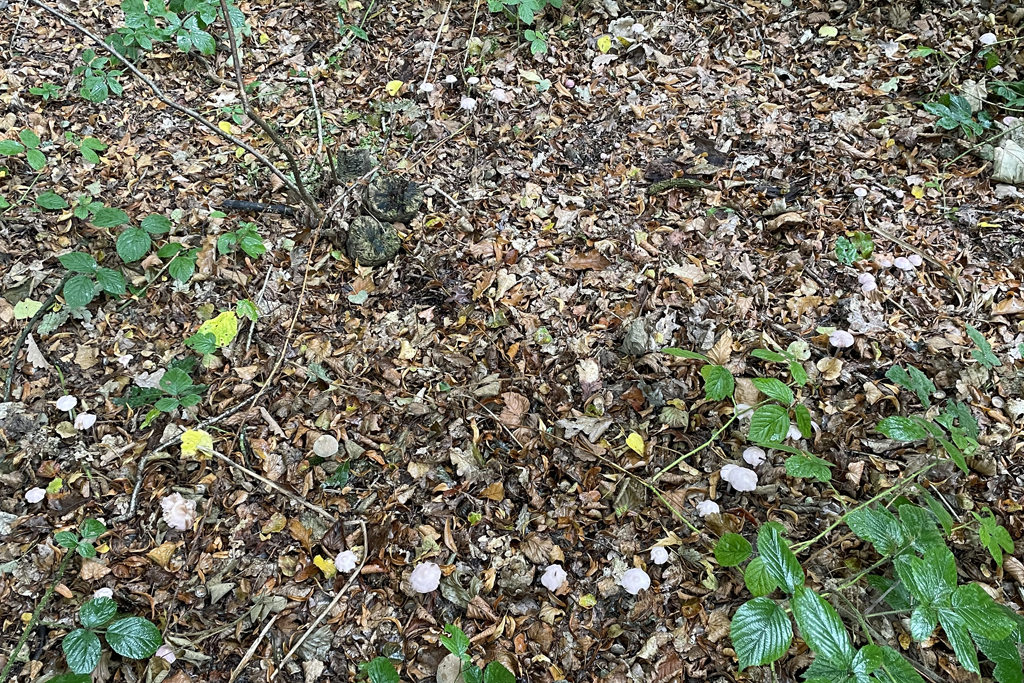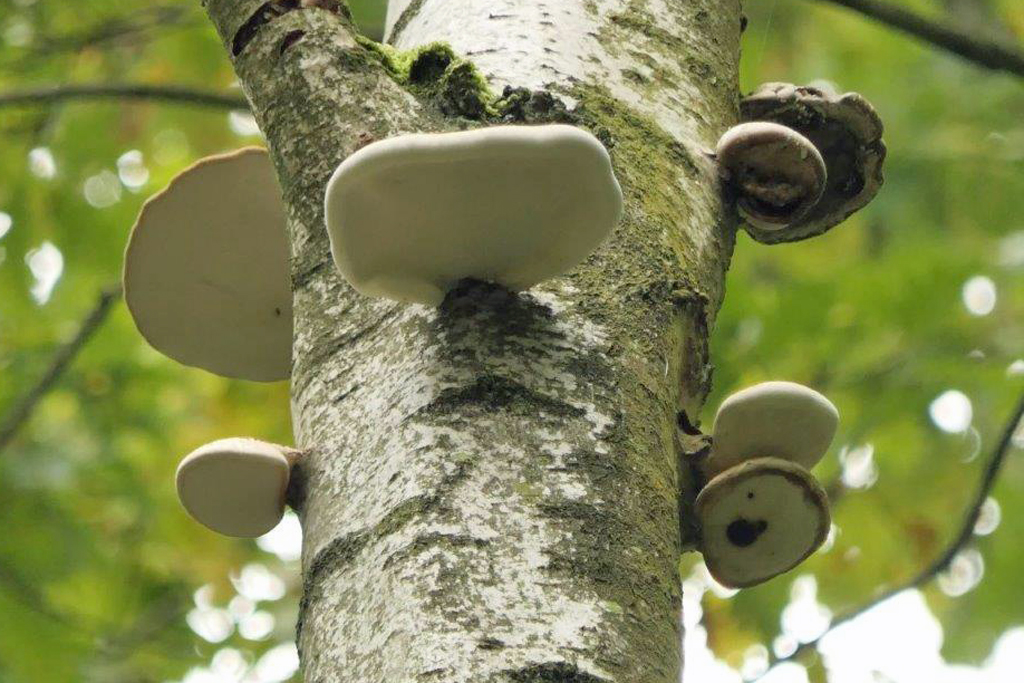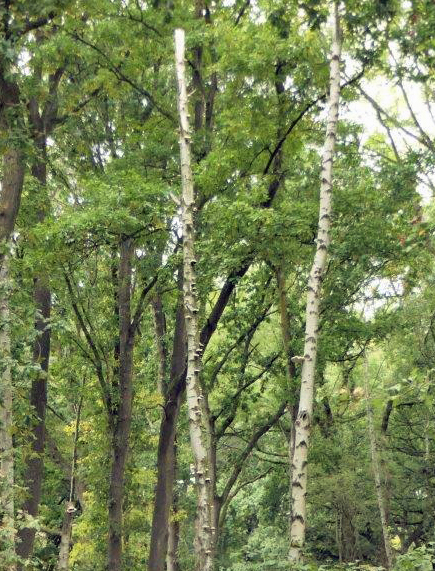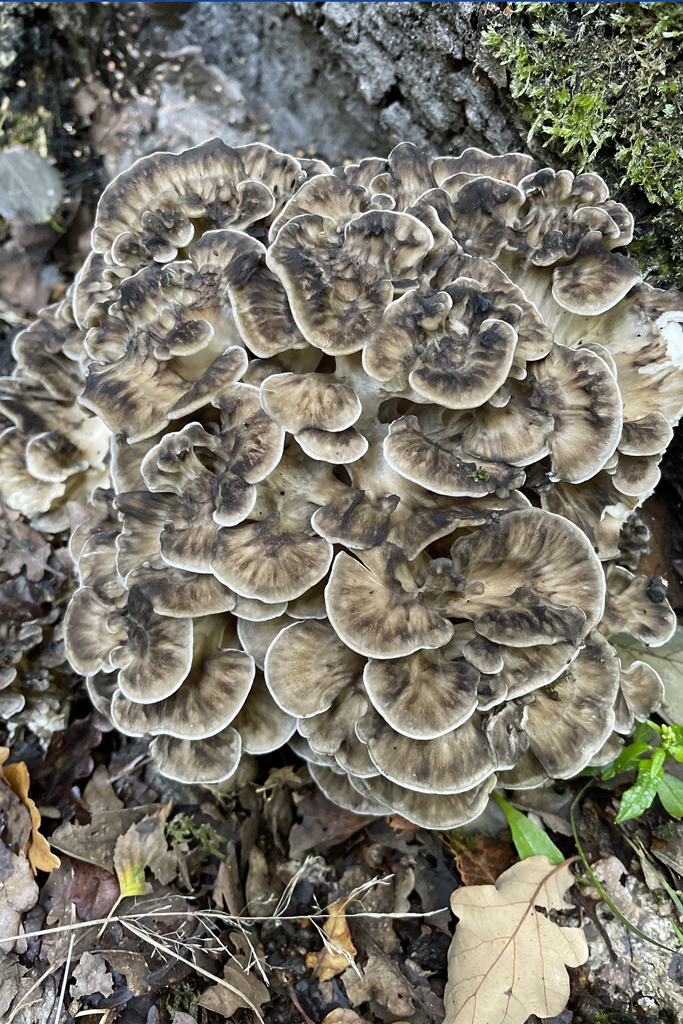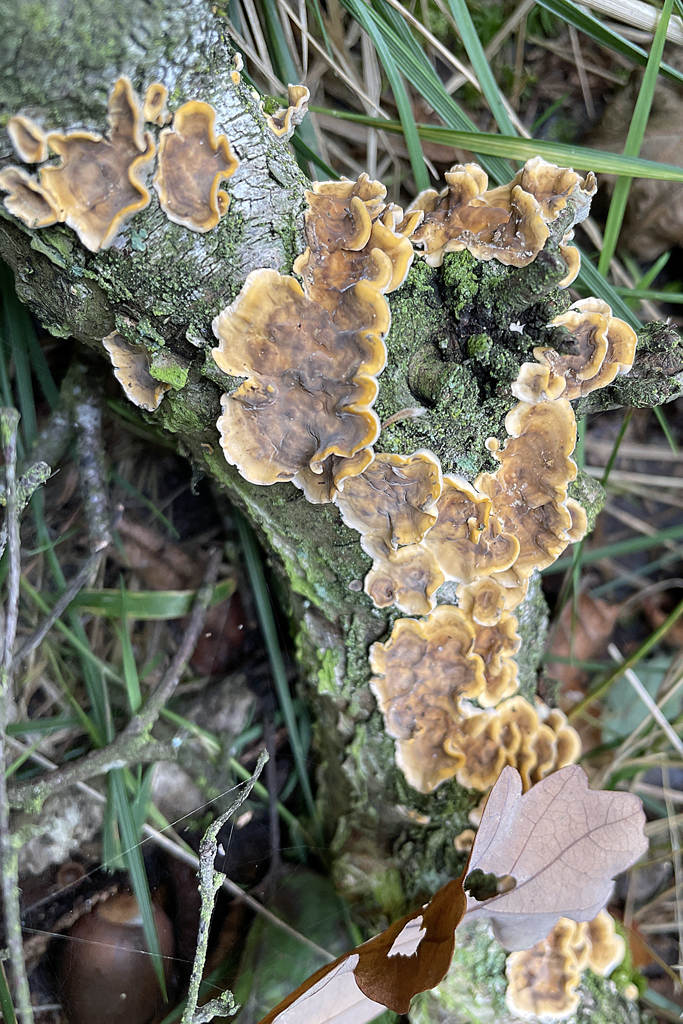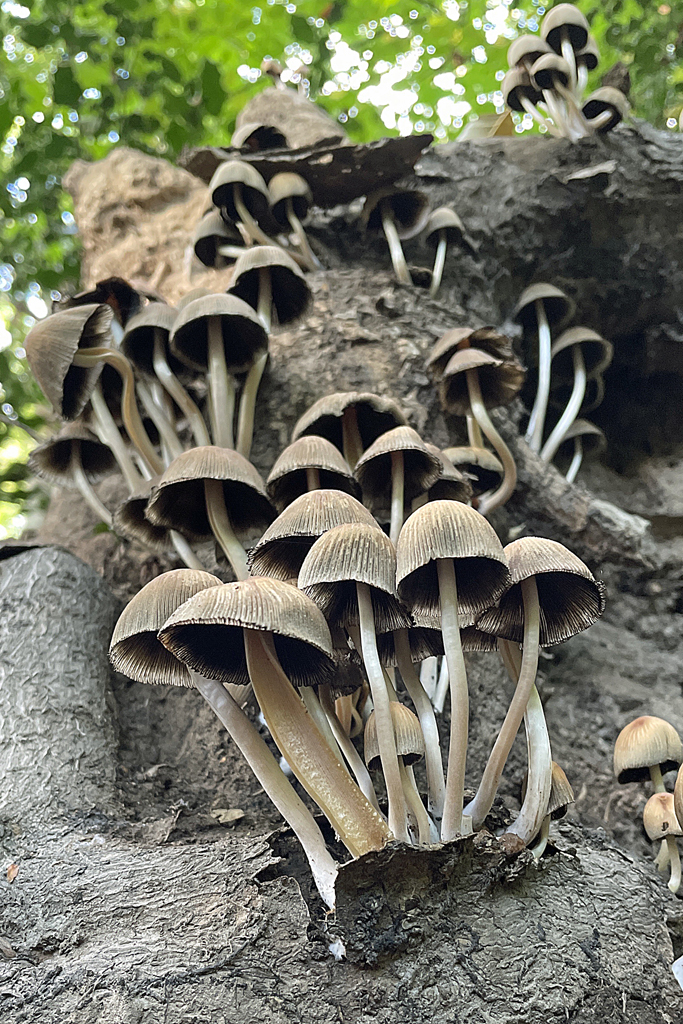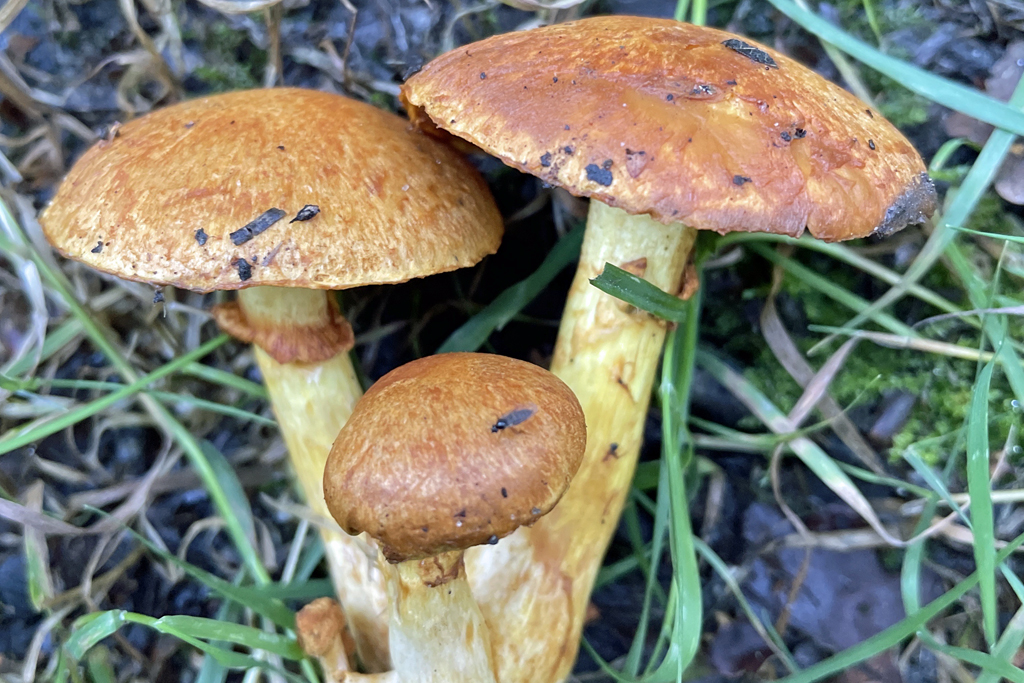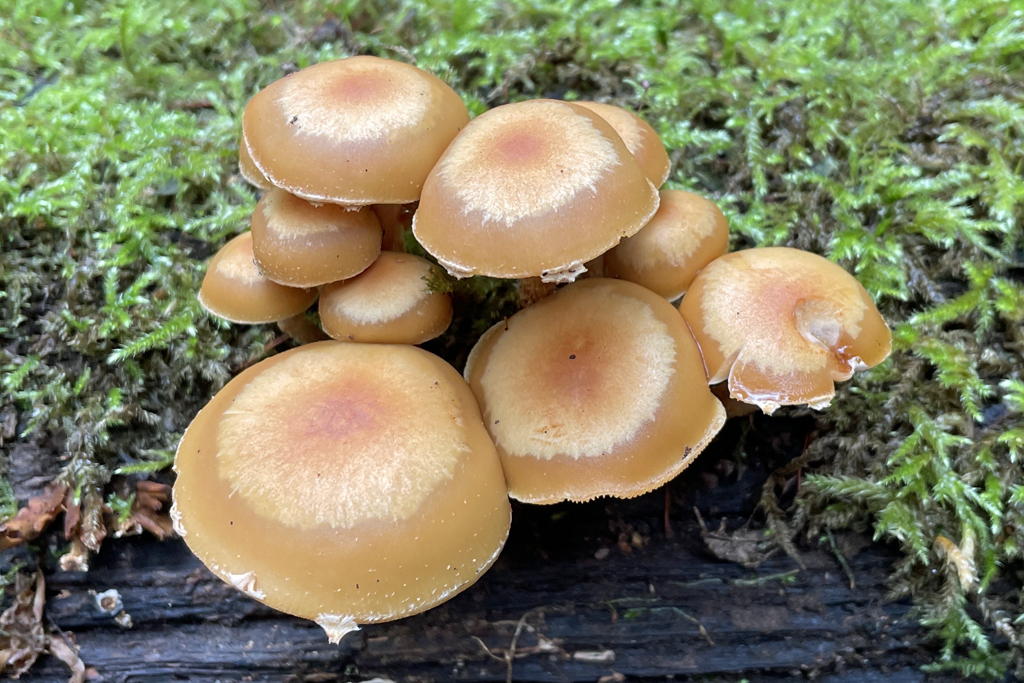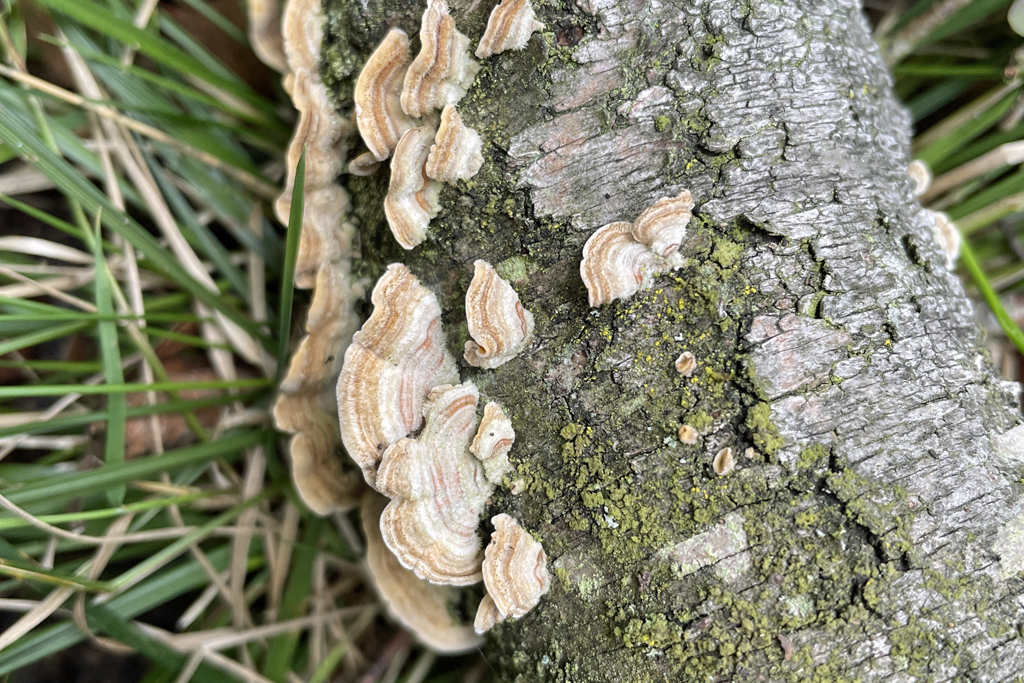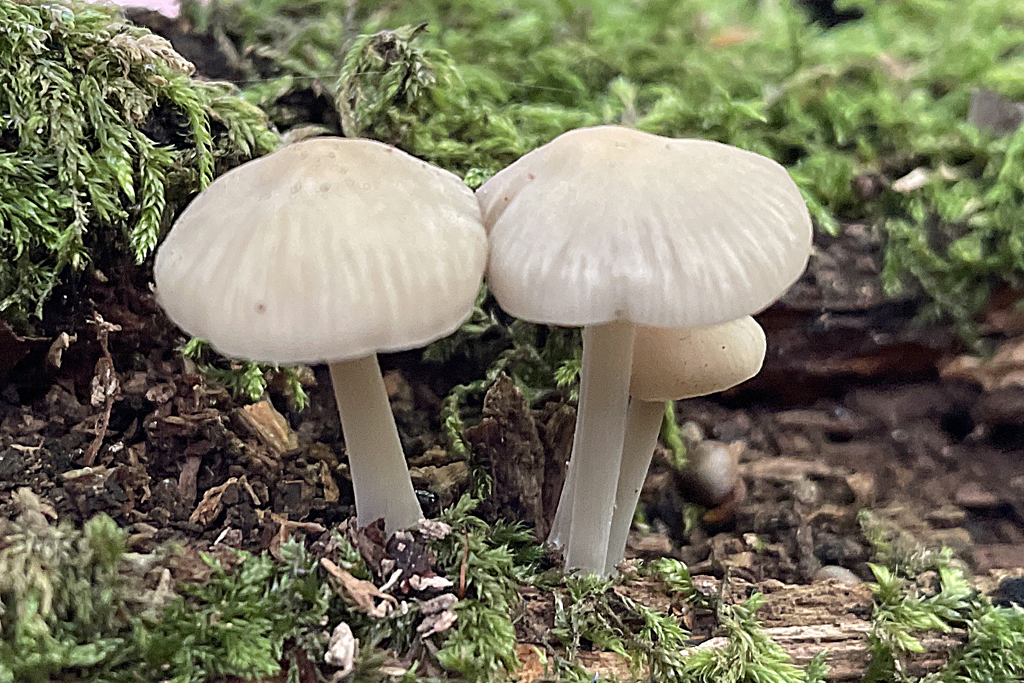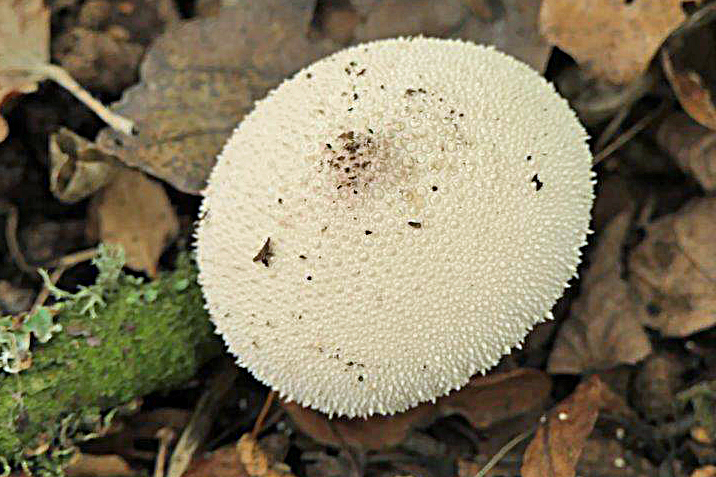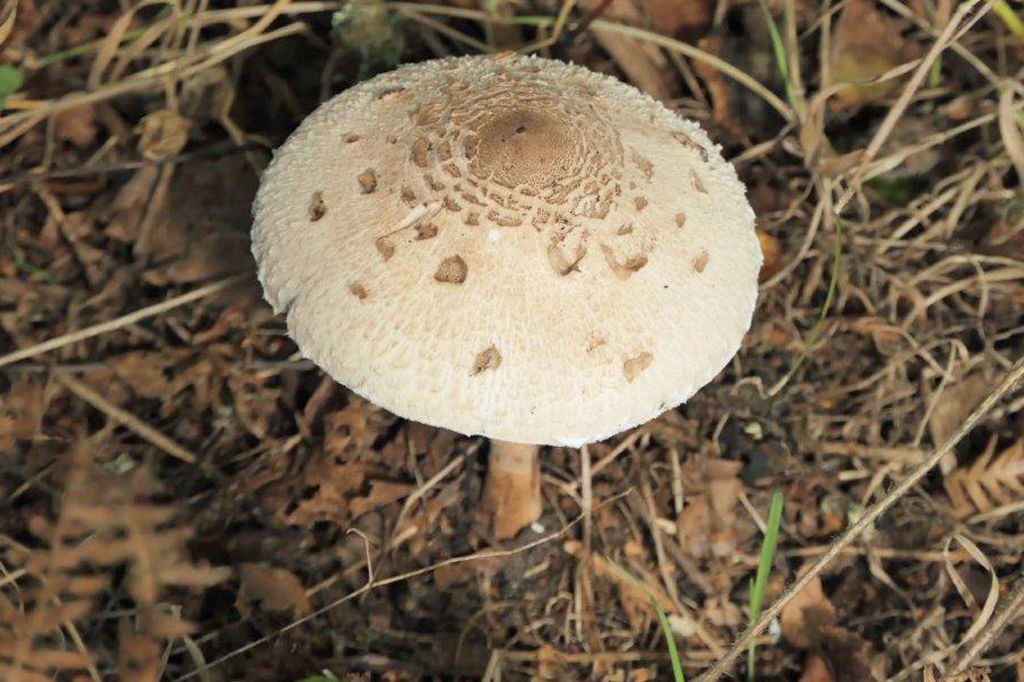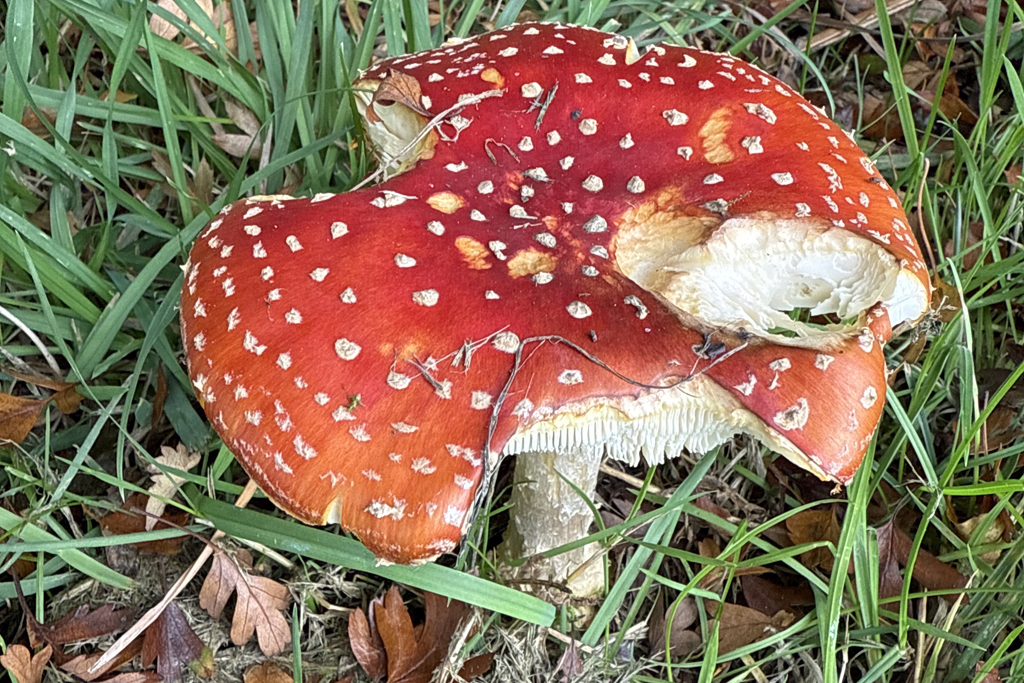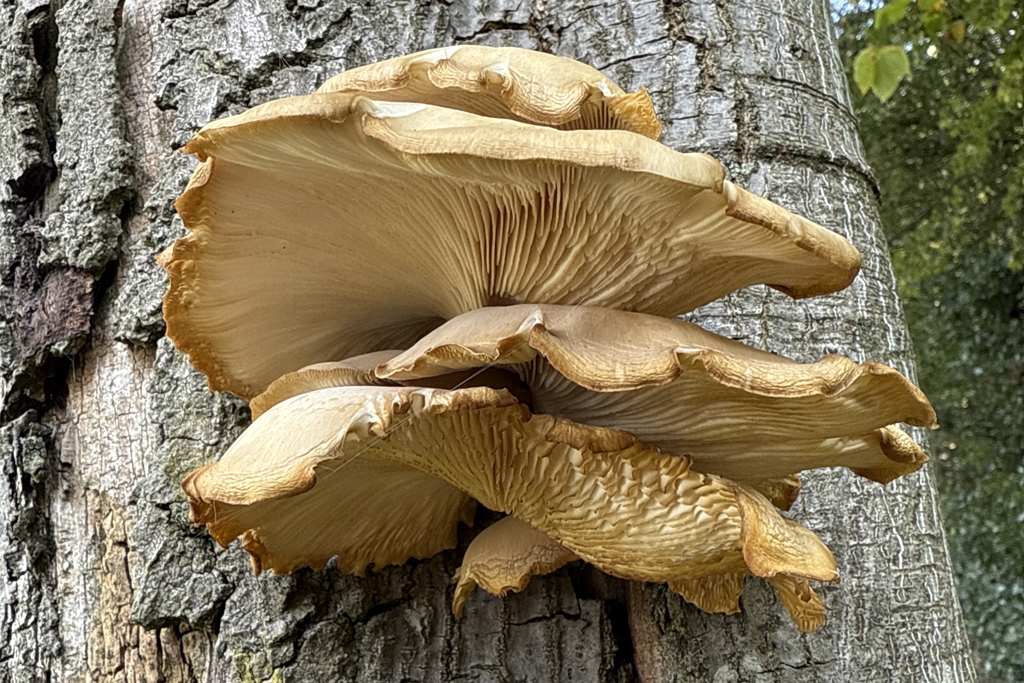Field Trip Swithland Wood
Field Trip to Swithland Wood North – 1 October 2025
Despite a drizzly start to the morning, 16 enthusiastic Members turned out to explore the northern portion of Swithland Wood. Our progress through the wood was predictably both slow and fascinating, indicative of the diverse ecology of this important site.
When the Grey Family began selling off some of the first parcels of land from their Estate in 1921, a local timber merchant originally purchased the land and began felling for commercial purposes. Recognising the ecological and recreational importance of this site, the Leicester Rotary Club fortuitously stepped in shortly afterwards and launched a successful appeal for the wood to be purchased in 1925, rescuing it from almost certain obliteration. It was then generously given to the Bradgate Park Trust in 1931 to manage in perpetuity alongside Bradgate Park for the benefit of wildlife and visitors alike. It is now a designated SSSI and contains some of the finest semi-ancient woodland in the County.
Our original intention was to complete a loop, incorporating the Great Pit in the centre of the woodland, but as ever, with so much to identify and record, we embarked instead on a shorter route, clocking up an impressive list of observations along the way.
Beneath our feet, our path was peppered with acorns, (not to mention those that landed on our heads), a reminder of just how incredible this ‘mast’ year had been following the prolonged drought of summer. Amongst the trees, the contact calls of Treecreeper, Wren, Blue Tit, Great Tit, Coal Tit, Long-tailed Tit, Goldcrest, Blackbird, Dunnock, Chaffinch, Great Spotted Woodpecker, Jay, Woodpigeon, Chiffchaff and Nuthatch mingled with the soft autumn subsong of Robin. Overhead, the mewing calls of Buzzard and the ubiquitous ‘chack’ of Jackdaws were ever-present.
Early into our walk, flowering Red Campion Silene dioica and Herb Robert Geranium robertianum provided a colourful contrast to the greens and browns of the ground vegetation which included: Herb Bennet Geum urbanum, Water Pepper Persicaria hydropiper, Enchanter’s Nightshade Circaea lutetiana, Dandelion Taraxacum sp., Garlic Mustard Alliaria petiolata, Pendulous Sedge Carex pendula, Male Fern Dropteris filix-mas, Bramble Rubus fruticosus agg., Common Nettle Urtica dioica and emergent saplings of Pedunculate Oak Quercus robur and Guelder Rose Viburnam opulus.The occasional Sessile Oak Quercus petraea was also noted.
We stopped briefly to admire the magnificent Black Pines Pinus nigra, their tall, straight trunks dwarfing the surrounding Oaks, Small-leaved Lime, Birch, Holly and Hazel. Stripped pinecones at their bases betrayed the presence of Grey Squirrel which appeared to be the only mammal evidence of the trip.
A single, exquisite green and black wing of a Merveille du Jour moth Griposia aprilina was found by one sharp-eyed Member. The larvae of this moth feed on the buds and flowers of oak and later on the leaves, whereas the adults feed on flowering Ivy and overripe berries. Other invertebrates included the carnivorous 7-Spot Ladybird Coccinella septempunctata, the larger Orange Ladybird Halzia sedecimguttata, which feeds on mildew, a Cranefly Tipula sp., European Hornet Vespa cabro, two Copper Underwing Amphipyra pyramidea and a Pale Tussock Calliteara pudibunda caterpillar wedged in a narrow fissure on the bark of an old oak tree. Another good find was the spikey white egg sac of the aptly named Sputnik Spider Paidiscura pallens attached to the underside of an oak leaf.
There were some fine examples of the mite-causing Lime Nail Gall Eriophyes tiliae, the wasp-causing Oyster Gall Neuroterus anthracinus on Oak, the midge-causing Hairy Beech Gall Hartigiola annulipes and the Holly Leaf Miner Phytomyza ilicis, a mining fly in the family Agromyzidae. A large cluster of the Oak Blotch-miner Tischeria ekebladella, a small moth, was then discovered on young oak saplings. The larvae of this moth mine the leaves and create a whitish blotch on the upper surface, within which they overwinter before pupating in the spring. A comprehensive list of micromoths, compiled by Graham appears at the end of this report. 2025 has been an exceptional year for the sheer density of other galls on Oak and many specimens of Smooth Spangle Gall Neuroterus albipes, Silk Button Gall Neuroterus numismalis, Common Spangle Gall Neuroterus quercusbaccarum, Artichoke Gall Andricus foecundatrix and Knopper Gall Andricus Quercuscalicis were found almost at every turn. Sycamore Tar Spot Rhytisma acerinum, an Ascomycete fungus was present on several trees. The spores, which are produced in spring, attach by their sticky coating to freshly emerged leaves but do no harm to their host. The fungus overwinters on fallen leaves.
As we approached an area known as ‘Druid’s Mound’, increasing numbers and variety of fungi provided plenty of interest and identification challenges. There were some magnificent specimens, many of which had only emerged in the last 24 hours following a good spell of rain.
Meanwhile, Andy was initially perplexed to find that the Merlin App, which he was running in the background, seemed to be persistently identifying the calls of Eider Duck – a coastal species not even remotely associated with woodland, let alone this area. We soon realised, much to our amusement that the App was picking up the many ‘ah-oooh!’ exclamations as we discovered more and more fungi along the track!!
Some of the memorable highlights included a beautiful ‘fairy ring’ of Rosy Bonnet Mycena rosea, an impressive clump of Hen-in-the Woods (Maitake) Grifola frondosa and a large Beef Steak Fistulina hepatica which had previously been cut into to reveal the layers of meat-like flesh. There were many clusters of the saprotrophic Sulphur Tuft Hypholoma fasciculare, cascading over rotting logs and a count of no less than 147 Birch Polypore Fomitopsis betulina on a single dead Birch stump.
The diminutive fungus Little Pin Rickenella fibula was found in large numbers, scattered across a wide area amongst the leaf litter in the clearing next to Druid’s Mound. Also in this area, we came across numerous specimens of Spectacular Rustgill Gymnopilus junonius, all of which appeared to have been systematically uprooted by something/someone and scattered under one particular Oak. Additional species included: Red Cracking Bolete Boletus chrysenteron, Sheathed Woodtuft Kuehneromyces mutablis, Brown Roll Rim Paxillus involutus, Yellowing Curtain Crust Stereum subtomentosum, Hairy Curtain Crust Stereum hirsutum, Glistening Inkcap Coprinellus micaceus, Common Bonnet Mycena galericulata, Common Stump Brittlestem Psathyrella piluiformis, Russet Toughshank Gymnopus dryophilus, The Miller Clitopilus prunulus, Suede Bolete Boletus subtomentosus, Common Puffball Lycoperdon perlatum, Bushing Bracket Daedaleopsis confragosa and Southern Bracket Ganoderma adspersum. It is fair to say that there were quite a few fungi which we did not have sufficient knowledge or experience between us to identify, but learning a little more each time is both satisfying and fun.
Our path then took us along the periphery of the meadow within the Wood. This is a SSSI in its own right for the variety of plants, some of which are quite rare in the County, including Toothwort Lathraea squamaria, Bitter Vetch Lathyrus linifolious and Bee Orchid Ophrys apifera. At this time of the year however, the meadow had already received its traditional annual mowing, so that from its edges, we could not clearly identify many species. A solitary mauve flower of the Devil’s-bit Scabious Succisa pratensis however, stood out together with a cluster of the four-petalled bright yellow Tormentil Potentilla erecta. Bordering the meadow, several clumps of Bilberry Vaccinium myrtillus, were recorded, while the outer bank was clothed in a rich array of Feather and Haircap mosses.
At the Picnic Site, the bark of numerous oaks supported the green, filamentous alga Trentepohlia. This alga is frequently orange, due to the presence of carotenoid pigments which mask the chlorophyll. While most of the wildflowers had died down in this clearing, the odd Red Campion Silene dioica was still showing, Blackberries, Rose Hips and Hawes and the red berries of Black Bryony Dioscorea communis added splashes of autumnal colour and the spent seed heads of Bugle Ajuga reptans could still be seen amongst the grasses.
We then entered Stocking Wood, a designated conservation area within Swithland Wood, and followed the narrow winding path which eventually looped back to the Picnic Site. In springtime, this woodland is ablaze with native Bluebells Hyacinthoides non-scripta, Ramsons Allium ursinum, Yellow Archangel Lamium galeobdolon and Yellow Pimpernel Lysimachia nemorum. At this time of the year however, the only trace we could find of these delightful plants were seed heads of the occasional Bluebell.
Common Bent Agrostis capillaris, Wavy Hairgrass Avenella flexuosa, Great Wood-rush Luzula sylvatica, Great Horsetail Equisetum telmateia, Wood Mellick Melica uniflora, Wood False-brome Brachypodium sylvaticum, Soft Rush Juncus effusus, Wood Sanicle Sanicula europaea and Greater Stitchwort Stellaria holostea were soon added to our list as we wove our way along the path, together with yet more fascinating specimens of fungi, including Hoof Fungus Fomes formentarius on felled, dead stumps of Silver Birch lining the track, and further examples of Brown Roll Rim Paxillus involutus, Sulphur Tuft Hypholoma fasciculare and Glistening Inkcap Coprinellus micaceus A climbing plant with curiously lobed leaves on Birch caught our eye which turned out to be a form of Ivy Hedera helix. Honeysuckle Lonicera periclymenum, was another climber in evidence, some leaves of which bore several fly mines. Grey Poplar and Alder were also identified as additional species in this area.
Our steps disturbed the occasional small Common Frog, no doubt benefitting from the recent rains which had moistened the leaf litter.
The path then emerged into a clearing, dominated by Bracken Pteridium aquilinum, which had superseded the stunning displays of Bluebells earlier in the year, before exiting to rejoin the main path back to the car park.
Our walk finished in warm sunshine and lunch was enjoyed at the Copt Oak, Markfield. Here, in the car park, a cluster of colourful red and white Fly Agaric Amantia muscaria under the hedgerow and a fine specimen of Oyster Mushroom Pluerotus ostreatus on the bark of an ornamental Lime completed our list for the morning.
Our thanks go to Sue and Jim Graham for leading this field trip and to Graham Finch, Hazel Graves, Howard Orridge and Steve Woodward for contributing additional records to this report.
Sue Graham
List of Moths Identified by Graham Finch:
Lime Dot (Stigmella tiliae), Nut-tree Dot (Stigmella microtheriella), Rose Leaf Miner (Stigmella anomalella), Fruit-tree Dot (Stigmella oxyacanthella), Shining Hawthorn Dot (Stigmella hybnerella), Speckled Hazel Dot (Stigmella floslactella),
Speckled Hazel Dot (Stigmella tityrella), Blue-shot Dot (Stigmella plagicolella), Golden Dot (Stigmella aurella), Beech Dot (Stigmella hemargyrella), Beautiful Sycamore Dot (Stigmella speciosa), White-banded Dot (Ectoedemia albifasciella), Ectoedemia occultella, Large Birch Dot (Tischeria ekebladella), Bramble Blotch-miner (Coptotriche marginea), Burnished Copper (Roeslerstammia erxlebella), Lime Tuft (Bucculatrix thoracella), Oak Tuft (Bucculatrix ulmella), Hawthorn Parornix (Parornix anglicella), Hazel Parornix (Parornix devoniella), Ilex Leaf-miner (Phyllonorycter messaniella), Common Thorn Leaf-miner (Phyllonorycter oxyacanthae), Cherry Leaf-miner (Phyllonorycter cerasicolella), Beech Leaf-miner (Phyllonorycter maestingella), Nut Leaf Blister Moth (Phyllonorycter coryli), Phyllonorycter nicellii, Hazel Leaf-miner (Phyllonorycter acerifoliella), Sycamore Leaf-miner (Phyllonorycter geniculella), Apple Leaf Miner (Lyonetia clerkella), Amber Hook-wing (Ancylis mitterbacheriana), Little Beech Tortrix (Strophedra weirana).
